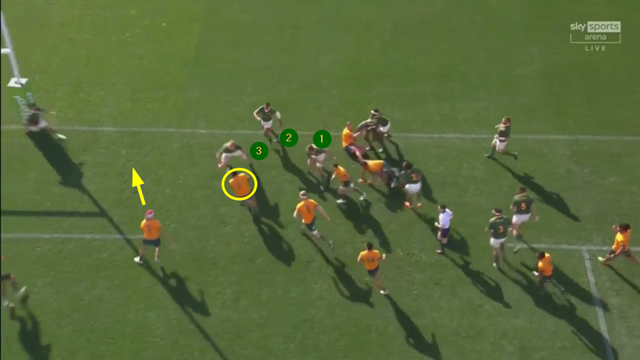Last year I wrote an article examining the use of the so-called ‘tip-on’ pass https://www.therugbysite.com/blog/attack/when-is-the-tip-on-pass-most-effective . The main thrust of that piece was how to use the tip-on pass in midfield, within a forward pod off number 10 to hit the soft spot in a defence.
More commonly, the tip-on pass is employed off the scrum-half. So, what are the conditions for the successful use of the same pass off number 9, where the space tends to be more claustrophobic, and there are more players packed into the defensive line?
For a quick recap on the basic purpose of the tip-on pass, we can return to the start of the original article:
“The tip-on is a quick transfer from one forward to another in a three-man pod – typically from the middle player of the three to the outside. The idea is that the speed of the transfer will be quick enough to create a hole which the defence will be unable to fill.”
The recent third round Rugby Championship match between Australia and South Africa at the Adelaide Oval illustrated several scenarios where the tip-on pass off number 9 can be very effective.
The most orthodox example occurred in the 17th minute of the first half, with the Springboks hot on attack near the Wallaby 22:

Typically, the third defender out from the side of the previous ruck with align opposite the expected ball-carrier (here, Springbok second row Eben Etzebeth) with a triangle forming around him or her. The third defender moves forward into contact as the ‘tip of the wedge’, ahead of the two players on his inside and outside.
This automatically makes the tip-on more effective. If the pass is precise, it will make the defender at the head of the triangle irrelevant, and shift play into an area where the defence will have to make a more passive, rather than a dominant tackle.
In this instance, Etzebeth makes the transfer to the man outside him (his partner in the second row, Lood De Jager), who is able to penetrate the soft space between the Australian fourth and fifth defenders, forwards Allan Alaalatoa and Matt Philip.
Australia had clearly focused on the use of the tip-on pass off 9 in their preparation for the game, and they did it for a specific reason. Let’s cycle back to the 5th minute of the game to see why:

The Wallabies employ the tip-on between the receiver (number 8 Bobby Valetini) and the forward outside him (open-side flanker Fraser McReight). South Africa dutifully form a triangle with De Jager opposite Valetini at its head, and the Wallabies are able to make a few easy metres and set up quick ruck ball.
The key difference is that De Jager is the fourth defender out from the ruck, not the third. The Springboks have inserted an extra ‘Guard’ right next to the breakdown to defuse the threat posed by Australian scrum-half Nic White, and his dangerous running from the base. On some occasions, they packed two extra defenders in that area, not just one.
Those extra defender(s) make the tip-on pass even more effective. Let’s cycle even further back, right to the sequence after Australia regathered their own opening kick-off.
In this example, Matt Philip receives the pass opposite the fifth defender (De Jager again) and that creates some space down the short side on the next phase.
The importance of the tip-on pass became critical when play bounced back off the right side-line for a second time:

Philip gets the ball away in the tackle to the man outside him (Wallaby hooker Folau Fainga’a), at a moment when he is already opposite the fifth defender, and the yawning hole Fainga’a is ready to run into is obvious in the overhead screenshot.
On the following play, the same pattern is repeated in miniature. The Springboks over-defend White again, and the space opens for McReight on the end of a tip-on from Alaalatoa:

It is worth looking at the same sequence from overhead ‘eagle’s eye’ camera angle:
Both Philip and Alaalatoa draw the head of the defensive triangle before they shift the ball outside to a man in space, and McReight is so close to the goal-line that he can fall over it to score.
Summary
The tip-on pass off 9 can be effective when you draw the defender up on point opposite your forward receiver. It can be lethal when you establish a threat from your scrum-half as a runner off the base, and the defence feels compelled to add an extra defender in between the side of the ruck and that first receiver. There will be space outside, even on the end of a short pass, and that is all the space you need.












.jpg)

.jpg)







